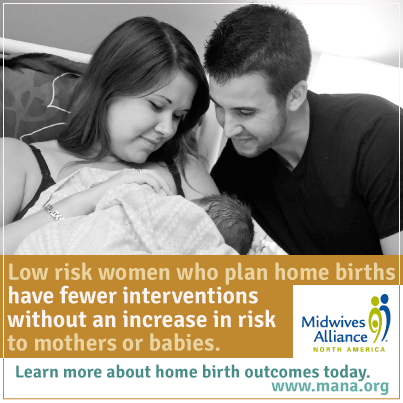
Both my children were born at home. Both of my home births involved complications that were not indicated by prenatal care. Due to highly trained midwives, both my babies and myself were fine.
Despite my experiences, do I believe home birth is safe? Yes. Absolutely yes.
A new study published in the peer-reviewed journal Journal of Midwifery & Women’s Health (JMWH) confirms home birth in the United States is safe for low-risk women.
Midwives Alliance of North America (MANA) explains:
This study, which examines nearly 17,000 courses of midwife-led care, is the largest analysis of planned home birth in the U.S. ever published.
The results of this study, and those of its companion article about the development of the MANA Stats registry, confirm the safety and overwhelmingly positive health benefits for low-risk mothers and babies who choose to birth at home with a midwife. At every step of the way, midwives are providing excellent care. This study enables families, providers and policymakers to have a transparent look at the risks and benefits of planned home birth as well as the health benefits of normal physiologic birth.
Previous studies relied on birth certificate data, as MANA noted, which flawed results because which it only reflects “the final place of birth (regardless of where a woman intended to give birth)”.
Quality prenatal care is essential for pregnancy, whether a birth is planned at home or for a hospital. In my experience, which seems to be consistent with midwifery care, prenatal care with a midwife far exceeds that of a doctor or certified nurse midwife working in a clinic or office.
My average midwife appointment lasted 45 minutes and delved into the social and emotional well-being of my family, as well as my physiological health.
My average doctor or certified nurse midwife appointment was about 15 minutes. Tests were run. Very little conversation ensued. Appointments were never on time, typical of the medical profession. I was herded in and herded out. Of course I chose the best doctors and CNM for my parallel care, but the system is not set up in the same manner of attention as midwifery care.
The difference in experience extended to postpartum care. My midwives continued to visit me and check on the baby and family. In the typical medical scenario, the mother does not see the doctor again until six weeks postpartum and care of the baby is shifted to a pediatrician. This is especially concerning when you consider the reality of postpartum depression.
Is home birth right for every birth? No. High quality prenatal care, which you are more likely to receive with a midwife, will reveal what pregnancies are low risk and therefore will benefit from home birth.
MANA continues:
Of particular note is a cesarean rate of 5.2%, a remarkably low rate when compared to the U.S. national average of 31% for full-term pregnancies. When we consider the well-known health consequences of a cesarean — not to mention the exponentially higher costs — this study brings a fresh reminder of the benefits of midwife-led care outside of our overburdened hospital system.
Home birth mothers had much lower rates of interventions in labor. While some interventions are necessary for the safety and health of the mother or baby, many are overused, are lacking scientific evidence of benefit, and even carry their own risks. Cautious and judicious use of intervention results in healthier outcomes and easier recovery, and this is an area in which midwives excel. Women who planned a home birth had fewer episiotomies, pitocin for labor augmentation, and epidurals.
Most importantly, their babies were born healthy and safe. Ninety-seven percent of babies were carried to full-term, they weighed an average of eight pounds at birth, and nearly 98% were being breastfed at the six-week postpartum visit with their midwife. Only 1% of babies required transfer to the hospital after birth, most for non-urgent conditions. Babies born to low-risk mothers had no higher risk of death in labor or the first few weeks of life than those in comparable studies of similarly low-risk pregnancies.
Critics of this study like to use scare tactics, and of course no one wants anything to happen to their baby or themselves. What I find important in this study is the reliability and validity of the study methods, as well as the results.
My 3 children were born at home and I can list a million reasons I went that route, but I’ll only list the top few, because I think it’s important people hear how normal it is. My midwife knew how to explain the process both scientifically and in simple concepts and would take 1+ hours per visit. She gave me simple tips that were the key to easing through contractions. She taught us that she isn’t delivering the baby, that the baby and I were doing it, giving us the power, the understanding that we CAN do it, and do it in the positions most natural. The lights were dim (she used a flashlight), the energy was calm. She encouraged my husband to get in there and support me where I needed it. Bottom line is childbirth is as natural and as intimate as sex, and by the way it is a sexual act. It’s not a medical condition, unless something is wrong. I wouldn’t go to the hospital to have sex. I wouldn’t jump out of a plane unless I was coached by a professional who would do it the exact same way, over and over. Point being, my gut tells me that if a doctor had to give birth year after year (hypothetically), over and over, they too might choose homebirth. You wanted me to speak my mind, right?
Excellent! Thank you for sharing!